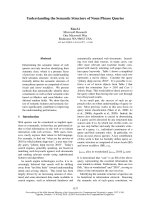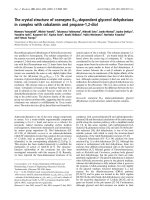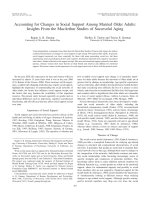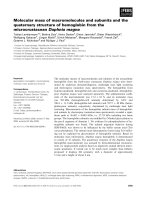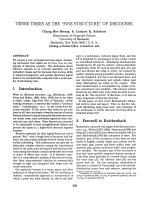The Organisational Structure of Banking Supervision ppt
Bạn đang xem bản rút gọn của tài liệu. Xem và tải ngay bản đầy đủ của tài liệu tại đây (117.28 KB, 54 trang )
FSI Occasional Papers
No. 1 – November 2000-10-25
The Organisational Structure
of Banking Supervision
by
Prof. C.A.E. Goodhart
Financial Stability Institute
Bank for International Settlements
Basel, Switzerland
Charles Goodhart, CBE, FBA is the Norman Sosnow Profes-
sor of Banking and Finance at the London School of Economics
(LSE). Before joining the LSE in 1985, he worked at the Bank
of England for seventeen years as a monetary adviser, becoming
a Chief Adviser in 1980. In 1997 he was appointed one of the
outside independent members of the Bank of England’s new
Monetary Policy Committee until May 2000. Earlier he had
taught at Cambridge and LSE. Besides numerous articles, he has
written a couple of books on monetary history, and a graduate
monetary textbook, Money, Information and Uncertainty (2nd
Ed. 1989); and has published two collections of papers on
monetary policy, Monetary Theory and Practice (1984) and
The Central Bank and The Financial System (1995); and an
institutional study of The Evolution of Central Banks, revised
and republished (MIT Press) in 1988.
Contents
The Organisational Structure of Banking Supervision
Foreword v
Abstract vii
I. Introduction 1
II. Arguments for Separation 8
III. Arguments for Unification 24
IV. Are the Issues the Same in Emerging Countries? 34
V. Conclusions 43
Bibliography 45
v
Foreword
It gives me great pleasure to present this first in a series of
occasional papers published by the Financial Stability Institute.
The purpose of these papers is to create awareness of, and pro-
vide information on, topics of interest to financial supervisors.
For this first paper the Financial Stability Institute requested
Professor Charles Goodhart (London School of Economics) to
write about banking supervision and its relationship to central
banks.
Traditionally, it has been considered ideal to place banking
supervision under the umbrella of central banks because this
function is key to the conduct of monetary policy and financial
stability oversight.
Recently, many countries around the world have been moving
banking supervision outside their central banks. What are the
advantages and disadvantages of this policy decision? Professor
Charles Goodhart addresses this question. Furthermore, an im-
portant contribution of his work is to focus this issue from
the point of view of emerging-market countries.
We present this work with the hope that it will provide policy
makers with key factors they should take into consideration in
the design of the most appropriate structure of their supervisory
systems.
John G. Heimann
Chairman
Financial Stability Institute
November 2000
vii
The Organisational Structure
of Banking Supervision
by Prof. C.A.E. Goodhart
1
Financial Markets Group
London School of Economics
Abstract
In this paper I try to address the question of whether, and why, it
matters whether banking supervision is undertaken in-house in
the Central Bank or in a separate specialised supervisory institu-
tion. After all, the banking supervisors and those in the Central
Bank concerned with systemic stability must continue to work
closely together wherever the supervisors are physically located.
Nevertheless there has been some recent trend towards hiving
off banking supervision to a separate agency, as with the Finan-
cial Services Authority (FSA) in the UK. The main driving
forces behind this tendency are the changing, more blurred,
structure of the financial system, and continuing concerns with
conflicts of interest. As the dividing lines between differing
kinds of financial institutions become increasingly fuzzy (e.g.
universal banks), continuing banking supervision by the Central
Bank threatens both inefficient overlap between supervisory
bodies and a potential creep of Central Bank safety net, and
other, responsibilities into ever-widening areas. With the accom-
panying trend towards Central Bank operational independence
in monetary policy, continued Central Bank supervisory
1
My thanks are due to P. Armendariz, C. Briault, G. Caprio, T. Dubouchet, P. Jackson,
G. Kaufman, R. de Krivoy, D. Llewellyn, G. Schinasi, D. Schoenmaker, M. Taylor,
P. Tucker, D. Walker, W. White, and participants at a BIS seminar for helpful comments.
Responsibility for all views and remaining errors remains with me.
viii
authority enhances concerns about potential conflicts of interest,
and raises issues about the limits of delegated powers to a non-
elected body.
On the other hand, separation of supervision from the Central
Bank raises questions whether systemic stability might suffer.
The ethos, culture and concerns of the separate supervisory body
might come to focus more on conduct of business and customer
protection issues. Potentially systemic financial crises would
have to be handled by a committee, not by a unified Central
Bank. How much, if at all, would the collection, transmission
and interpretation of information relevant to a Central Bank’s
concerns, both on monetary and systemic stability policy issues,
be lost as a consequence of separation?
These are, mostly, qualitative issues, and more developed
countries, with differing historical, legal and institutional
backgrounds, will, and have, come to differing conclusions.
But in less developed countries, more weight needs to be
placed on ensuring the quality of the supervisory staff, i.e. their
professional skills, independence from external pressures, and
adequate funding. These latter considerations tell strongly
towards retaining banking supervision under the wing of
the Central Bank in emerging countries.
1
I. Introduction
In 1997 the newly elected Labour Government in the United
Kingdom transferred responsibility for the prudential supervi-
sion of commercial banks from the Bank of England to a newly
established body, the Financial Services Authority (FSA). The
FSA was to take on responsibility for, and combine, both the
prudential and the conduct of business supervision for virtually
all financial institutions (banks of all kinds, finance houses,
mutual savings institutions, insurance companies, etc.), and
financial markets. So, during the course of 1998 most of the
banking supervisors who had been working together in a desig-
nated section of the Bank moved together, en bloc, to the new
headquarters of the FSA at Canary Wharf, a few miles further
east.
The same people continued to do the same job. What then
had changed?
2
Moreover, the commercial confidentiality of
their work had meant that their offices in the Bank had previ-
ously been sealed off internally from the rest of the Bank
(Chinese Walls!). Given the increasing ease of long-distance
communication (by e-mail as well as telephone and fax), would
channels of information really be that much changed by the
physical move?
2
The FSA would, I believe, argue that what has changed is that it can take advantage of
the efficiency benefits of a unified supervisor, to be discussed in Section (II)(a) below,
by putting greater emphasis on the integrated supervision of financial groups, and, more
generally, put the regulation of banks on a basis that is more closely correlated with the
regulation of other parts of the financial services industry (see ‘A New Regulator for the
New Millennium’, FSA (2000)).
2
One possible answer could be that both the physical location
and the organisational structure of the financial supervision of
banks are, indeed, a second-order problem. It is not the purpose,
or intention, of this paper to argue whether, and if so exactly
how, financial institutions need to be supervised. On the main-
tained assumption that some such supervision will continue to
be needed, the banking/financial supervisors will ha
ve to work
closely with the Central Bank, and vice versa, whatever the
organisational structure.
However much the Central Bank is focussed on macro-economic
issues of monetary and price stability, the achievement of such
macro objectives rests on the basis of maintaining micro-level
financial stability, in the payments system, in the banking system,
and the smooth working of the financial system more broadly. So
the Central Bank will have an on-going concern for financial
stability and financial regulation; a Central Bank will feel that it
needs to be in close and continuous contact with the supervisory
body, however that may be organised. By the same token, the
health and profitability of the financial system depend on the
macro-conjuncture; the supervisory authorities will want to learn
from the Central Bank what may be expected on this front.
No one particularly likes having an older relative looking over
their shoulder, and an independent supervisory body may be
jealous of its own independence. Indeed, such amour propre
may be one of the obstacles to a full and satisfactory flow of in-
formation. Nevertheless a sensible supervisory authority would
realise both that the Central Bank should act as a partner in any
proposed change in the regulatory structure, and that, as a super-
visory body, it has no ability on its own to provide financing (to
lend or to create money) to financial institutions needing some
financial injection. Again, it is not the purpose of this paper to
argue whether, when and how Lender of Last Resort (LOLR)
functions should be carried out. But, should the supervisory
3
body want to propose the injection of extra funding into the
financial system, it needs to obtain the approval of the Central
Bank (and nowadays in most cases also of the Ministry of
Finance) so to do. In the first instance, and normally, LOLR func-
tions would be carried out by the Central Bank. It is certainly
possible to conceive of a banking supervisor approaching its own
Ministry of Finance directly in order to use taxpayers’ funds to
obtain resources for such a financial injection. But if that were
done behind the back, or against the professional wishes, of that
country’s Central Bank, it would surely trigger the resignation
of that Bank’s Governor and a (constitutional) crisis within, and
amongst, the monetary authorities. Perhaps the resignation
of Miguel Mancera from the Central Bank of Mexico in 1982,
when there was an overriding political imperative to bail out
banks using public money, could be cited as a possible example.
So, whatever the details and form of organisational structure,
those in charge of banking supervision and those in the Central
Bank most concerned with financial stability are, perforce, go-
ing to have to work together. If so, it could be argued that the
precise details of the organisational structure are, at most, of
second order importance, and that the scale of attention given to
this issue in practice is an indication of the incidence of ‘turf
wars’ rather than of matters of real substance.
In support of this proposition, one can adduce the fact that the
organisational relationship between banking supervision and
Central Banks has been established in many separate ways in
different countries (see Goodhart and Schoenmaker (1995a and
b), and Goodhart, Hartmann, et al. (1998)). There are undoubt-
edly some changing factors that shift the balance towards a pref-
erence for one, or other, institutional structure – and these will
be discussed further below – as well as changing fashions of
viewpoint in this field. Nevertheless the fact that organisational
diversity has been so prevalent indicates that it may not have an
4
overriding influence on outcomes. Despite some studies claim-
ing to find significant differences on a variety of outcomes
dependent on the organisational structure adopted (see, for
example, Heller (1991), Briault (1997), and Di Noia and Di
Giorgio (1999)), the practical implication of the observed diver-
sity could be that it is not a matter of first moment. Indeed, the
problem of trying to assess the best organisational structure is
not made easier by the propensity of all institutions, notably
including Central Banks, to argue, and with great cogency, that,
whatever their present structure may be, it is optimal
, or at least
would be if some slight additional funding and powers could
be made available to it!
If we accept, as a maintained hypothesis, that banking supervi-
sors and the Central Bank should work closely together what-
ever the organisational structure, why should that structure mat-
ter? There are numerous reasons, most of which will be outlined
and discussed subsequently. One of the main reasons for con-
cern about such differences is that organisational structure may
have some influence on the type of people involved in the exer-
cise of banking supervision, their calibre and professional skills,
and the ethos and culture of the organisation in which they
work.
3
At the outset of this Introduction we described how the
same individual banking supervisors who had worked at the
Bank of England were now still mostly working at the FSA.
4
But
in five, or ten, years time will the skill-structure, outlook and
incentives of those working in this capacity at the FSA be the
same as if responsibility for this function had remained with
the Bank? And will the Bank also retain its skills to handle crises
3
Schoenmaker and I, with the assistance of some research assistants, are analysing the
results of a survey of supervisory bodies on these issues. Unfortunately the results are
unlikely to be available until some time in the future.
4
A study, in a couple of years time perhaps, of who stayed and who left, and why, might be
interesting, but is beyond the scope of this paper.
5
(see Ferguson (2000) and Greenspan and Federal Reserve Board
(1994))? One of the features of this paper is that we shall em-
phasise the issue of the influence of organisational structure on
the personnel involved, particularly with respect to emerging
and transitional countries.
In so far as the maintained assumption that banking supervisors
and the Central Bank must continue to work closely together,
hand in glove, remains, then the obvious (default) solution would
seem to be to keep banking supervision within the Central Bank.
Information flows must surely be enhanced, differences of view
patched up, and decision making expedited and facilitated by such
internalisation. The fact that price stability and financial stability
go hand-in-hand, and have historically always been seen as
doing so, would seem to provide a strong a priori argument in
favour of keeping them organisationally unified within the Central
Bank
5
(see Volcker (1984)), though, perhaps, in a semi-detached
manner, as has been achieved in recent decades in their various
ways in both France and Germany.
6
5
Pauli (2000) concludes, p. 25, that
‘Legal stipulations, appropriateness and strong complementary links form the basis for the
central bank’s three basic functions: controller of the money supply, settlement agent, and
macroprudential supervisor/payment system overseer. Together these constitute an inte-
grated whole. It would not be possible to leave out one of the functions without seriously
hampering the conduct to the other two.’
Also see H. Kaufman (2000), p. 219, as follows:-
‘As I see it, the proper responsibility of the central bank - assuring the financial well-being
of society - requires an intimate involvement in financial supervision and regulation. In
fact, I have long believed that it is only the central bank - among the various regulatory
agencies that share responsibility in this area - that can represent the perspective of the
financial system as a whole. This should be the central organizing principle behind any
comprehensive reform of financial regulation and supervision in the United States.’
6
One needs to be careful about interpretation, as David Llewellyn (personal correspon-
dence) has reminded me. What happens in practice is often quite different from what
appears to be the case simply by observing the formality of institutional structure. The cen-
tral bank often has a significant role in supervision even when it is not formally the agency
responsible. Practice is seldom as clear-cut as formality.
6
Roger Ferguson Jr, a Governor of the Federal Reserve Board, in
a 1998 conference speech (published 2000), covered much the
same ground as this paper. He was, clearly, making the case for
the Federal Reserve maintaining a significant role in banking
supervision, a case that the Federal Reserve Board has argued
cogently in recent decades (e.g. Volcker (1984) and Greenspan
and Federal Reserve Board (1994)). He argued that, p. 301:-
‘In the last analysis, there simply is no substitute for under-
standing the links among supervision, regulation, market behav-
ior, risk taking, prudential standards, and – let us not lose sight
– macro stability. The intelligence and know-how that come from
our examination and regulatory responsibilities play an impor-
tant – at times, critical – role in our monetary policy making. No
less relevant, our economic stabilization responsibilities con-
tribute to our supervisory policies. Observers and supervisors
from single-purpose agencies often lose sight of how too rigor-
ous or too lenient a supervisory stance – or a change in stance –
can have serious and significant macro-economic implications,
the consideration of which is likely to modify the supervisory
policy.
In short, I think the Fed’s monetary policy is better because of its
supervisory responsibilities, and its supervision and regulation
are better because of its stabilization responsibilities.’
And yet the current tide is running now quite strongly in the
opposite direction.
7
The Wallis Report in Australia, the establish-
ment of the FSA in the UK, much of the advice of the IMF
to its member countries
8
(whether developed or not), recent
7
See Tuya and Zamalloa (1994).
8
Several Fund officials have, however, written to me personally to say that the Fund is not
an unquestioning enthusiast for unification, and prefers a country-by-country (case-by-
case) approach.
7
developments in Korea and Japan,
9
and proposals in South Africa
and India, all have moved towards the separation of financial
supervision from Central Banks.
10
In the eurozone a separation
between monetary policy (at the federal level) and banking super-
vision (at the national level) has occurred de facto, though many
commentators are unhappy with this separation (see Goodhart
(2000), and Dubouchet (2000)). Such separation has already been
established in most Scandinavian countries (Denmark, Iceland,
Norway and Sweden).
11
Indeed, there are cogent reasons ad-
vanced for advocating such a separation, and the grounds for this
shift have become stronger in the light of current developments.
Partly because we have started, in this Introduction, by setting out
the historical, a priori, case for internalising banking supervision
within the Central Bank, we shall move on next in Section (II)
to outlining the reasons advanced for se
paration. We shall do so
first within the context of more developed countries. Then, in
Section (III), we shall return to arguments in favour of combina
-
tion, again sticking primarily to the case as seen amongst devel-
oped countries. In Section (IV) we shall move on to review some
of the additional issues relevant particularly to de
veloping and
emerging countries. Section (V) concludes, and contains some
suggestions for future research.
9
Although Japan has now established a single regulator (very similar to the FSA in the UK),
the Bank of Japan still undertakes on-site inspections of major banks, i.e. those which are
its counterparties in the payments system.
10
On this, see Briault (1999), especially Section 2 on ‘Developments in Other Countries’.
Others, however, would contend that the momentum towards separation is not that strong.
One Central Bank regulator has written to me (personal correspondence) as follows:-
‘You may have overstated the ‘trend’towards separation of banking supervision from cen-
tral banks, at least in the developed world. When we looked at the Basel Committee mem-
bers, we found that only one – UK – had taken away banking supervision from its central
bank since the Committee was founded. There were a number of other countries where the
central bank was not the main banking supervisory agency, but these were very long stand-
ing arrangements.’
11
See How Countries Supervise their Banks, Insurers and Securities Markets, (1999), and
Taylor and Fleming (1999).
8
II. Arguments for Separation
a) The Changing Structure of the Financial System
Initially in the course of development commercial banks have
provided most of the services of financial intermediation. When,
thereafter, a variety of other financial intermediary services de-
veloped, e.g. investment banking, insurance, fund management,
etc., etc., it so happened historically (notably between 1930 and
1970) that macro-economic developments and the fashion of
policy led to the enforcement of strict demarcation lines
between the various financial intermediaries and their functions,
e.g. the Glass-Steagall Act in the USA. Moreover, for much of
this period (1930–1970) and in many countries, there were di-
rect controls on competition between such intermediaries, and
on the quantities, and pricing, of the business that they could do.
The quid pro quo for the existing intermediaries was control
over new entry and the establishment of controlled prices/inter-
est rates at levels that ensured a comfortable franchise value.
The result, in many cases, was the establishment of cartelised
clubs of semi-specialised intermediaries, for whom the oligopo-
listic structure, and with official encouragement, led to the es-
tablishment of largely self-regulating clubs with agreed rules of
conduct.
This oligopolistic structure, with limited competition and guar-
anteed franchise value, reduced the likelihood of financial
failure; following the recovery from the great depression in the
1930s until the 1970s, the incidence of financial failure and
crises plummeted, partly because of international stability
achieved by the Bretton Woods arrangements. This reduced, in-
9
deed almost obviated, the need for hands-on banking, and
financial, supervision. Until the Fringe Banking Crisis in
1974/75, the Bank of England restricted their direct supervision
to a small number of Merchant Banks (the Accepting Houses)
and to the Discount Market, stemming from the Bank’s own
credit exposures. The supervisory function was carried out by
one single senior official, the Principal of the Discount Office,
with a handful of staff! So, historically, the conduct of banking
supervision did not
, in practice, play a really large, or central,
role in Central Bank activities
12
because the structure both
reduced the need for such an exercise and allowed it to be
largely achieved through self-regulation (though this may have
been particularly so in the UK, and less representative of other
countries). In the USA, the Federal Reserve only really became
a major player in banking regulation and supervision with the
enactment of the Bank Holding Company Act in 1956, which
gave it authority over Bank Holding Companies.
13
Limitation of competition and oligopoly hindered competition,
efficiency and innovation. The protected and regulated financial
system that emerged after the end of World War II eventually
gave way under the assault of international competition (mostly
emanating from the USA); technological innovation (mostly in
information technology); a drive for greater efficiency and
improved services for customers; and a return to enthusiasm
for liberal, market-based, ideology. The greater competition
placed downward pressure on profitability, capital ratios and
franchise values. Financial instability and failures became more
prevalent. Central Banks found themselves increasingly in-
volved in supervisory activities. Some would add that poorly
12
My colleague, Dirk Schoenmaker, reminds me that banking supervision started seriously
rather earlier in some continental European countries, Germany with the Reich Banking
Law of 1934, and the Netherlands with its Banking Law of 1948.
13
I am indebted to G. Kaufman for this information.
10
designed regulation and safety nets then became a further cause
of bank failures.
These same forces, however, were blurring the previously clear
boundaries between categories of financial intermediaries. Uni-
versal banking became more popular and commonplace. Bank-
ing became mingled with insurance, bank assurance, and both
undertook fund management. Eventually that meant that the
attempt to supervise separately by function
, e.g. commercial
banking, investment banking, fund management, etc., would
involve a multiplicity of separate supervisors, all crawling over
parts of the same single institution. This was hardly efficient or
cost effective.
The boundaries between financial intermediaries had become
thoroughly blurred.
14
Borio and Filosa (1994) were, perhaps, the
first to explore the consequences of this for the structure of
financial supervision (also see Abrams and Taylor (forthcom-
ing)). So one obvious conclusion that was reached was equiva-
lently to place responsibility for the supervision of all financial
intermediaries in one institution. But this naturally caused a
problem for Central Banks, should they wish to maintain inter-
nal control of banking supervision. The logic of placing all
supervision under one roof would then require the Central Bank
to take responsibility for supervision over activities which lay
outside its historical sphere of expertise and responsibility. An
even more serious problem, than already exists, would arise of
how to demarcate the boundaries between those sub-sets of
depositors/institutions which would be covered by the ‘safety-
net’ (explicit or implicit), deposit insurance, Lender of Last
Resort facilities, etc., and those not so covered. Would the
14
Even so regulation – and some economies of specialisation? – sought to maintain bound-
aries between financial and non-financial businesses, with only limited success in some
notorious cases, e.g. Russia.
11
Central Bank really want to take under its wing the responsibil-
ity for customer protection in fund management? In practice,
much of staff time, even in banking supervision, is taken up with
customer protection issues (other than deposit insurance).
Would a Central Bank really want to extend its operational remit
to dealing with financial markets and institutions where issues
relating to systemic stability were limited, and customer protec-
tion of much greater importance, e.g. the pension mis-selling
scandal in the UK? So if efficiency and cost saving implied the
unification of financial supervision, this suggested placing such
a unified body outside the Central Bank (see, for an excellent
exposition, Briault (1999)).
But did it necessarily imply such unification? One alternative
proposal was to divide the structure of supervision not by market
function, e.g. banking, insurance, fund management, but by the
pur
pose of supervision. Here the suggestion was that supervi-
sion should be organised around the two purposes of systemic
stability (prudential supervision) on the one hand and customer
protection (conduct of business supervision) on the other; this
was the Twin Peaks proposal, pushed in the UK primarily in the
work of Michael Taylor (1995 and 1996). The supervisory body
charged with customer protection would naturally take the lead
in some areas, markets and institutions. Per contra, the body
charged with responsibility for systemic stability would take the
lead in dealing with the payments system, and with certain
aspects of banking and, perhaps, other financial markets. Even
so, there would remain considerable overlaps and duplication.
There are residual vestiges of the Twin Peaks concept in the
more unified systems adopted, e.g. in Australia and the UK. The
Central Bank usually maintains control of overseeing the pay-
ments mechanisms, and will have a much closer involvement in
those aspects of supervision potentially raising systemic con-
cerns. Nevertheless the Twin Peaks concept has, so far, not
found favour in practice, though, in a slightly inchoate manner,
12
the US system has evolved in a way that approximates to it, with
the Federal Reserve coming close to a systemic stability (pru-
dential) supervisor, and the SEC undertaking the conduct of
business role.
It is not clear, to me at least, quite why this has been so. There
would, undoubtedly, have been room for overlap and friction
between the two bodies involved; and having to deal with two
sets of supervisors would raise the cost to the supervised enti-
ties. On the other hand, there would have been some merit in
focussing each of the bodies on one particular purpose. A con-
cern that some have is that customer protection is almost certain
to take up the greater bulk of the staff’s workload within a uni-
fied supervisory body. Might then the requirements of maintain-
ing systemic stability, which has in the longer run larger effects
on real incomes and national wealth, come to play second fiddle
to a culture and ethos concentrating on customer protection?
Pauli (2000) comments that, ‘The different focus as between
investor protection and systemic stability is however so pro-
nounced that there are good arguments for having the primary
responsibilities for these two functions divided between separate
bodies.’
15
If the Twin Peaks concept had been adopted, it would have been
odd if the systemic stability group of supervisors had not been
kept within – or under the umbrella of – the Central Bank. One
reason for moving to a unified system may, indeed, have been to
extract supervisory responsibilities altogether from the Central
Bank. We shall come to reasons for advocating this shortly.
15
Ferguson, op cit, similarly argues, p. 299, as follows:-
‘But, I would also note that the argument for a single supervisory authority for all finan-
cial institutions contains a real risk – the risk of extending supervision and regulation be-
cause the agency with the single mission tends to forget or pay less attention to other pur-
poses, such as the effects of its actions on the economy.’
13
In practice, however, (a) to a large extent a ‘systemic stability’
regulator and a ‘customer protection’ regulator would approach
the regulation of a large bank in exactly the same way (so there
would be considerable duplication and overlap), and (b) as with
the FSA and its multiple statutory objectives, there is no reason
why a single regulator should not combine a number of objec-
tives and fine-tune its regulatory approach accordingly.
16
A somewhat different distinction, than between systemic stabil-
ity and customer protection issues, is that between top-down
(macro) and bottom-up (micro) approaches towards these same
issues. Most customer protection issues are micro, whereas
some prudential, stability issues are macro, with some micro. It
can be, and has been, argued that dividing the systemic stability
issues between top-down macro, kept with the Central Bank,
e.g. in the UK and in Australia, and bottom-up micro, all with an
independent agency (or agencies), reinforces clarity and respon-
sibility.
16
Clive Briault, op cit, writes:-
‘[T]he distinction between prudential and conduct of business regulation is not in practice
as neat and simple as Taylor’s twin peaks model might imply. Even without the emergence
of financial conglomerates, a large number of financial services firms would need to be
regulated by both of his proposed Commissions because their business would require both
prudential and conduct of business regulation. This would certainly include life insurance
companies, securities firms and institutional fund managers, and in practice would also
include the many banks and building societies who combine deposit-taking with various
forms of investment business. This in turn would generate inefficiencies (firms
having to be authorised and supervised by more than one regulator) and the possibility of
the communication, co-operation and consistency problems discussed earlier.
Moreover, there is a considerable overlap – both conceptually and in practice – between
prudential and conduct of business regulation. Both have a close and legitimate interest in
the senior management of any financial institution subject to both of these types of regula-
tion, in particular because of the crucial roles of senior management in setting the ‘com-
pliance culture’ of a firm, in ensuring that management responsibilities are properly allo-
cated and cover comprehensively the business of the firm, and in ensuring that other
internal systems and controls are in place. The detail of some of these systems and controls
may indeed be specific to either prudential or conduct of business considerations, but
many of them will be more general.’
14
For example, in its Annual Report, June 2000, the BIS is
concerned that a purely micro-level concern with the treatment
of risk could have unforeseen, and unintended, effects at the
aggregate level.
17
This might be dealt with best by interacting
the top-down expertise of the Central Bank with the bottom-up
approach of the supervisor. If both approaches were subsumed
within the Central Bank, one or other might be suppressed or
overlooked.
b) International Issues?
First, however, we should also note that amongst the boundaries
that have been crumbling have been the geographical limitations
of the financial activities of commercial institutions to their own
nation state. The largest financial entities are now multinational.
The contrast between such multinational commercial activities
and the inevitable reliance of regulators and supervisors on
na
tional laws (since regulation depends on law, and law-making
is in the domain of the sovereign state), produces many strains,
see for example the G30 paper on Global Institutions,
National
Supervision and Systemic Risk (1997). It is, however, far less
clear whether, and why, such commercial multinationalism
would influence the choice of national structure.
17
BIS, op cit, p. 149
‘[M]uch more attention should be paid by the public sector to monitoring developments
and to developing analytical procedures for evaluating the risk of systemic problems. In-
deed, using stress tests as a corollary to such forecasts also has a lot to recommend it.
Whether analyses of this sort should be done primarily by supervisors or by other bodies
(commonly central banks) charged with overall responsibility for systemic stability, or by
both, needs to be clarified to ensure that this important function does not simply fall be-
tween the cracks. One argument for involving central banks is that there may be a useful
complementarity between their ‘top down’ approach and the ‘bottom up’ approach more
commonly followed by the supervisory community. It is a simple but important insight that
many recommendations supporting prudent behaviour at the level of a single firm can
have undesirable effects if a large number of firms have simultaneously to alter their be-
haviour in the same way. Fallacies of composition of this kind are well known in the
macroeconomic literature.’
15
In so far as (most of) the major banks in any one country have
their headquarters, and site of consolidated supervisory over-
sight, in another country, that would imply that the (smaller)
country dominated by foreign banks might take a somewhat
more relaxed view of banking supervision (e.g. New Zealand).
But such a possible relaxation could occur whatever the domes-
tic structure. Such multinational commercial activity places
greater emphasis on cross-country co-operation amongst regula-
tors and supervisors; for example, who provides the financial
support and who takes on the fiscal loss in the case of the col-
lapse of an international bank? Central Banks have been
renowned for their collegial approach, fostered by the good of-
fices of the BIS. But international co-operation on such
issues is hardly going to be damaged if each country should now
send two representatives (i.e. from its Central Bank and its sepa-
rate supervisory body) to the Basel meetings of supervisors.
18
It is sometimes suggested that the multinational operations of
major banks, and other financial entities, may reduce the ability
of domestic Central Banks to control macro-economic monetary
policy within their own country. But so long as the Central Bank
maintains a floating exchange rate regime, its capacity to control
its own short-term interest rate, and growth rate for the monetary
aggregates, is not impaired by the global spread of business. The
Central Bank will maintain as much concern for price stability,
and with that for financial stability, in a world of international
commercial entities, as it had when its financial firms were over-
whelmingly national in coverage.
18
Ferguson, however, argues that the longer-standing, and possibly better, international link-
ages of Central Banks provides yet another argument for keeping banking supervision in
Central Banks. Thus he writes, p. 300, that
‘Globalization of financial markets means that crises in any financial market have signifi-
cant effects in other nations’markets – in fact, there is increasingly only one global finan-
cial market with the interbank connections occurring in both credit and payments flows.
The institutions best able to coordinate and address these problems are the world’s Cen-
tral Banks.’
16
The assessment of the situation changes, however, when the
Central Bank switches from a floating exchange rate to a fixed
rate. The extent of fixity can vary from an irrevocably unified
exchange rate, as in the eurozone, through dollarisation, as in
Panama and now in Ecuador, through to a Currency Board
regime, as in Argentina, Estonia and Hong Kong. In each case
the Central Bank loses the power to control macro-economic
monetary policy. That consideration tells both ways. On the one
hand, if Central Banks are to lose their macro-economic role,
what is to be their function, their raison d’etre, if they do not
hold on to their other responsibilities, notably for supervision?
Indeed, a radical might ask whether, without some supervisory
function, they will really be needed at all in future; perhaps just
an historical (and expensive) monument. Concerns for institu-
tional survival will cause Central Banks when stripped of their
macro-economic role to argue more strenuously for retention of
their other activities, notably banking supervision.
But by the same token Central Banks in such a subsidiary state
(subsidiary to a hegemonic Central Bank, e.g. the European
Central Bank (ECB) or Federal Reserve), have less ability to
create money (and perhaps undertake LOLR functions, but that
issue remains moot for the National Central Banks (NCBs) in
the ESCB), on their own. They have less independent power to
maintain financial stability. Indeed, the ability of the monetary
authorities in some such circumstances to intervene may depend
more on the fiscal ability of the Ministry of Finance to make
euros/dollars available for financial intervention than on the
capacity of the Central Bank to take loans on to its own
balance sheet. In such circumstances LOLR becomes even more
directly a fiscal measure than a monetary action. So the question
of the role of the Central Bank will depend largely on its
relationship with the relevant fiscal authorities in the pursuit of
financial stability.
17
Nevertheless the multinational coverage of the major financial
intermediaries means that supervisors and regulators in any one
country have a concern with the standards and competence of
such supervision/regulation in other countries, especially where
such intermediaries may have their headquarters. Such concern
can be met (minimally) by the agreement of codes, or principles,
of good conduct in these fields. Such codes have proliferated in
recent years, multiplying at an almost exponential rate. Beyond
codes, there can be agreements on minimum standards, either at
a regional level, as in the European Community Directives, or
globally, as in the Basel Accords on Capital Adequacy.
It is relatively simple to agree on codes, on what represents good
behaviour. It is more difficult to monitor and to apply sanctions
for infringement. But international sanctions do exist. Publicity,
or ‘naming and shaming’, is an important instrument, e.g. as
used by the Financial Stability Forum to grade the relative status
of supervision among off-shore centres.
19
Beyond publicity, the
possibility of excluding intermediaries in the offending coun-
tries from financial markets elsewhere would represent a strong,
and quite credible, potential punishment.
Perhaps as difficult and important as sanctions is the problem of
how to monitor (banking) supervision and regulation elsewhere,
an issue of importance in so far as a financial crisis in one coun-
try might have contagious spill-over effects on other countries.
Suggestions have been made that such international monitoring
could be done by one, or other, or a combination of international
financial agencies, e.g. BIS, IBRD, IMF, or, perhaps, by a ‘col-
19
Such gradings provoked much concern, in some cases fury, amongst the authorities in
some centres who felt that they had been judged without due process, without being able
to give evidence in rebuttal, and without the possibility of redress. Perhaps, but they could
always choose to invite outside observers to attest to their good offices. Moreover the
strength of reaction was testimony to the efficacy of the instrument.




